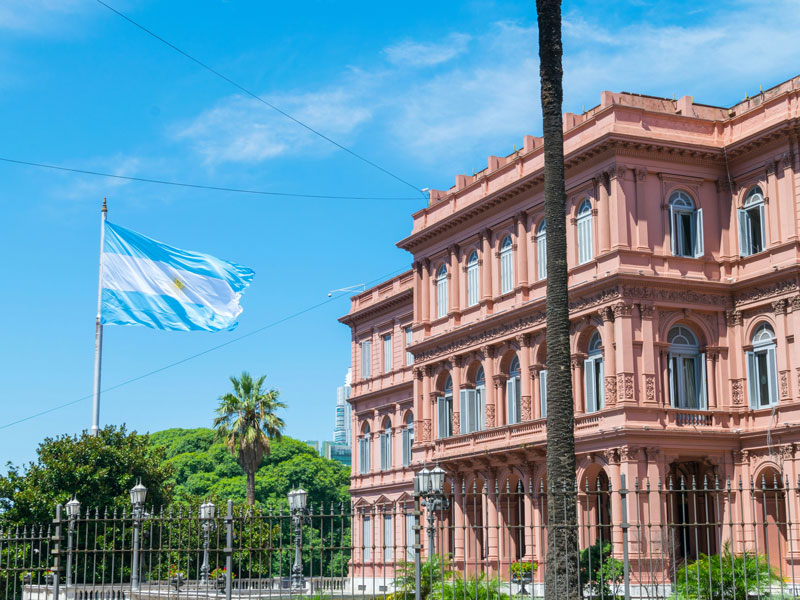The Making of Milei: madman or maverick? Chris Moss ponders the arrival of a new kind of leader in Argentina
posted on 22/01/24
In Buenos Aires’ many corner bar-cafes, some regulars – especially the older ones – still read proper print newspapers. They scour the by-lines and columns, especially the updates on inflation, the exchange rate, new government loans, debts and defaults. When I first arrived in the city in the early 1990s, one of the things that struck me about the bestselling daily, Clarín, was that the economic news was up front, before politics and crime, before the international crises, the wars and other global woes.
I suppose what can seem quite dry in other countries is, in Argentina, the most scandalous and colourful – some might say garish – aspect of current affairs. Since 1914, there have been five currencies. There have been 113 fiscal deficits over the last 123 years. Since 2001, there have been three defaults. Currency controls, export controls, import controls, parallel currency rates, hyperinflation: these are not rare occurrences in modern Argentinian history. There’s even a museum of external debt. The current one peso coin, worth almost nothing, is equivalent to 1.6 quadrillion 1914 pesos with the US dollar as reference – an average annual depreciation relative to the dollar of 28 per cent. Even as I write that, it’s erroneous. The peso-dollar rate changed this morning. It will change tomorrow morning too.
All of which is a numerical way of prefacing the plain truth that Javier Milei (b. 1970), the right-wing, libertarian firebrand, who – as part of his presidential campaign – threatened to shut down the Central Bank, dollarise the economy and erase several government ministries – does not come from nowhere. He isn’t the imbecile some commentators like to portray. He has degrees in economics, has written books and been chief economist at mainstream institutions. His nickname might be ‘El Loco’ but the socio-economico-political milieu he is supposedly upturning is loco too; he will, probably, be very much at home.
Economics cannot be separated from politics, and politics, in Argentina, has also been sensational, dramatic, singular. The 20th century began with a shift towards middle-class power and, in the figure of Hipólito Yrigoyen (president between 1916–22 and 1928–30), towards populist democracy. In 1930 there was a military coup – the first of six over the next 36 years. Juan Perón did not take power through a coup, but he sidled in via a military role, and created a new brand of politics that wove together left and right-leaning values and melded socialist policies to an authoritarian power-base. He shifted the national economic emphases from campo (country) to city, beef to industry, Anglo and US alliances to nationalist- trade-unionist hegemonies. His legacy was long; for some Peronism has been like a shadow, for supporters a ‘Peronist Day’ is always a sunny one. Over just two weeks between 20th December 2001 and 2nd January 2002, following the collapse of a free-market Peronist government (which, incidentally, pegged the peso to the dollar for a decade), Argentina had five presidents. The government that Javier Milei ousted was the most recent incarnation of Peronism. It is arguably the most enduring and chameleonic invention in South American party-political history.
When we visit Argentina with Martin Randall Travel, we use history as a thread to connect places, people and experiences. On the Making of Argentina tour to Buenos Aires, Córdoba and Salta, the narrative covers religious, imperial and political history and our route imposes a reverse-chronology: from the thrusting, metropolitan capital city to the Jesuit missions of the 18th century to the indigenous ruins and colonial-era commercial nexuses of the Andean regions.
Contemporary politics and current affairs arise along the way. I also ask local guides to share their news, thoughts, concerns. Even in Southern Patagonia, which feels remote from the chattering cafés and daily tumults of the big city, we shouldn’t forget that in 2003, Argentina elected Néstor Kirchner, a hitherto little-known governor from the province of Santa Cruz, as its president. The still highly influential archetype of the regional strongman or woman – the caudillo – has its roots in the provinces.
What does Milei’s enthronement mean for visitors? Is there cause for alarm? Will a run on the bank cause mayhem? No one can say. Argentina’s democratic foundations are in good shape. If they weren’t, a genuine outsider would never have been able to break through and win the election. A high incidence of poverty has increased insecurity in recent years, but Argentina is safer than most other Latin American countries and Buenos Aires much safer than large US cities.
There is also an Argentinian survival instinct – or perhaps it’s a spirit of self-reliance. The Penguin History of Latin America rightly heads its chapter on 20th-century Argentina ‘The Long Decline’. The transition from global breadbasket (Argentina was richer than France or Germany in 1913 and had a per capita GDP similar to Canada) to economic basket-case has ensured other areas of life – business, arts and culture, cuisine, sport, television – have built up walls of resilience. Even when money is tight and tension explodes in the form of strikes or protests, people keep working, writing, singing, cooking, fighting. Argentina is a work in progress. It is always fascinating. It is always morphing, muddling through, making it up as it goes along. Anywhere else, Milei would be a one-off and an aberration. But, frankly, he fits into this ongoing story of calamity, chaos and crisis. It might seem amazing to some that his homeland is so wondrous, creative and full of joy – but it is, I can assure you.
View itinerary for The Making of Argentina, 8–19 November 2024.
Image: Casa Rosada, the President of the Argentine Republic's official workplace. By Benjamin R. via Unsplash.
